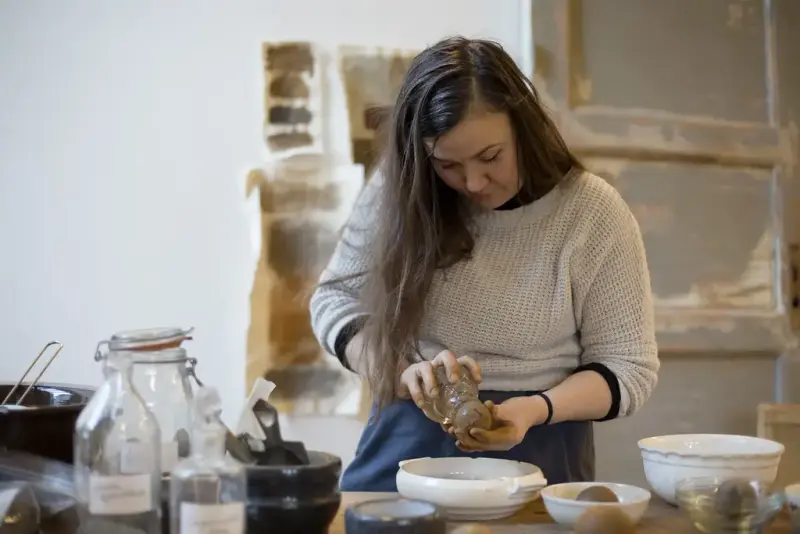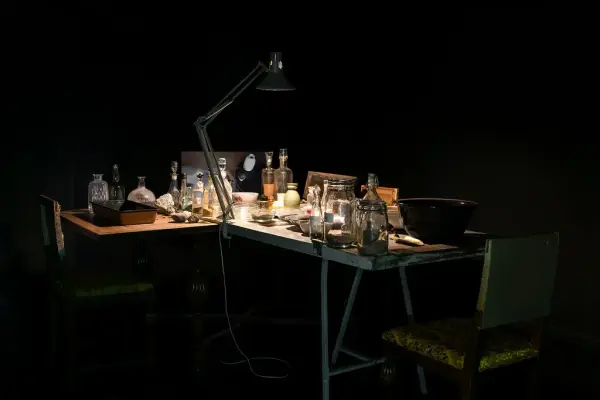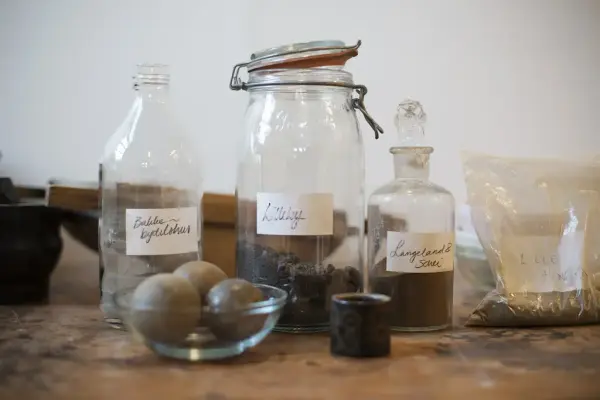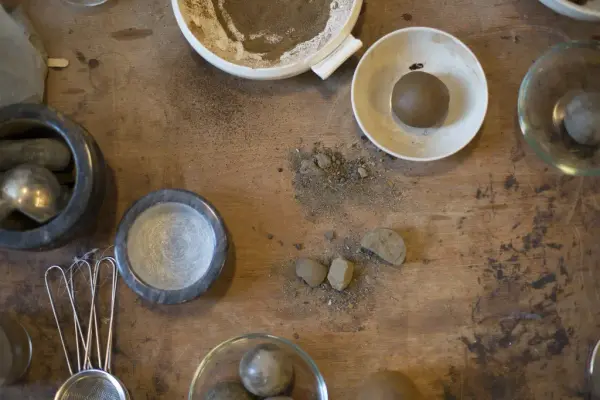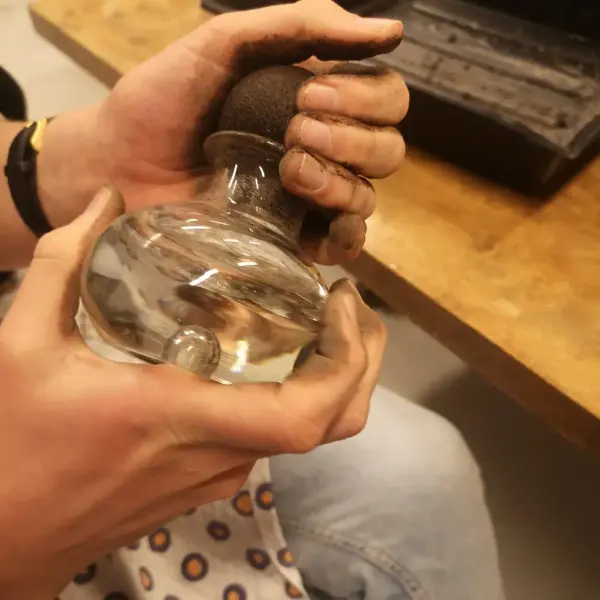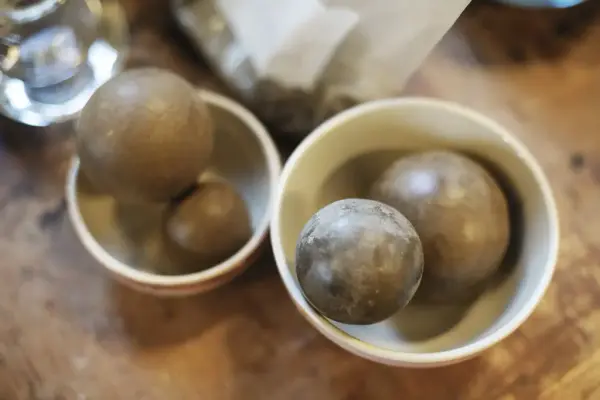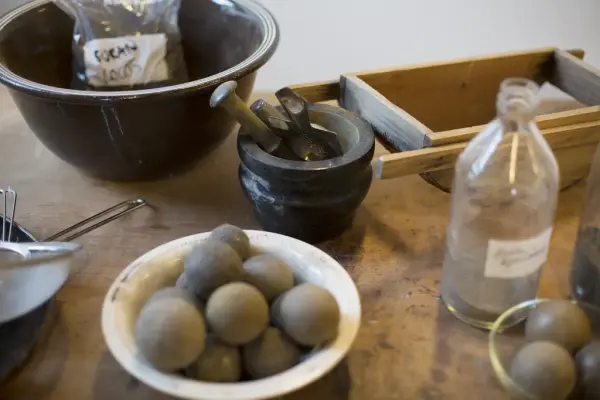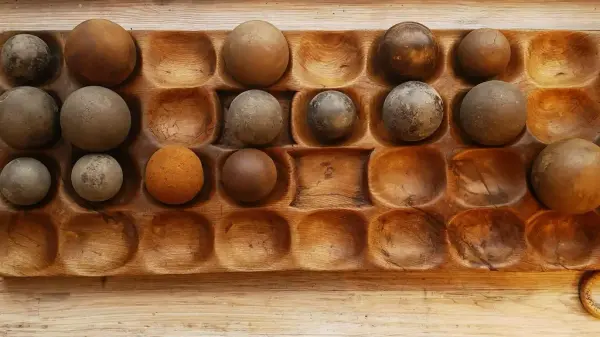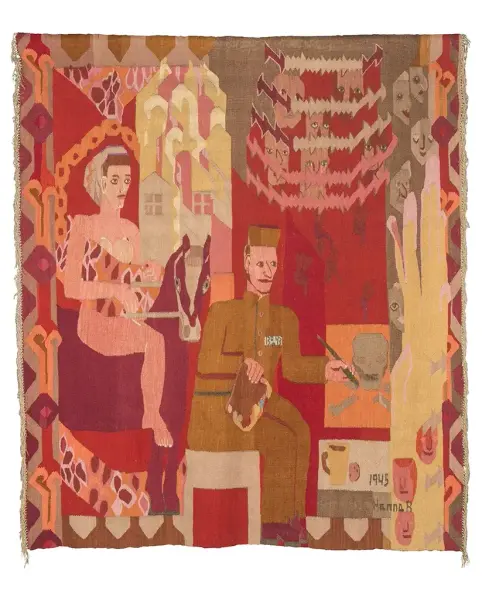Veslemøy Lilleengen
Grunntanker (Grounded Thoughts), 2021
Installation and workshop series
Variable dimensions
From the collection of Trondheim kunstmuseum
Soil is an elemental material. It is messy, organic, and deeply rooted in place. It carries traces of history, erosion, and life, shaping landscapes and personal experiences. Using the technique of dorodango, Veslemøy Lilleengen creates polished soil spheres from samples collected across the city of Trondheim.
It is said that dorodango was developed in Japan around 1300 years ago as an exercise for craftsmen. Today, the method is often used in an educational context. The process — taking raw, messy soil and carefully shaping, drying and polishing it into a smooth, reflective sphere — teaches children about material transformation, persistence, and the beauty of everyday substances.
Lilleengen draws on this slow, meditative process, not just as a craft technique but as a way of exploring our connection to place. The artwork bridges childhood play and artistic practice, turning something as ordinary as soil — often seen as dirty or mundane — into an object of reflection and meaning. Through this transformation, Lilleengen invites visitors to consider how we engage with the ground beneath us, both in memory and in the present moment.
The wordplay in the Norwegian title, Grunntanker, combines the ideas of “fundamental thoughts” (grunntanker) and “thoughts about the ground/soil” (grunn meaning ground or soil). Grunntanker invites the audience to contribute their own soil — from places they feel connected to, such as a former home or a site tied to meaningful memories. The work was born from Lilleengen’s need to symbolize her own shifting relationship with the land:
I come from a long line of farmers; I know how to stand on freshly ploughed land, I’ve always known where I belong. But in recent years, there have been nights when I’ve woken up afraid that I’ve forgotten how to plough, that after living more than half my life in the city, I’ve forgotten what it feels like to work with the soil.
The table is a central gathering point in our lives, serving as both a place to share meals and to focus on work. It is around the table that Lilleengen invites participants to join a workshop to make dorodango from soil they bring and to have a conversation about the places that connect them to this soil. Here, conversation is as essential as the materials; just as important as the finished spheres is the sense of community that grows from these shared reflections. Grunntanker centres on utensils displayed on the table. The latter is made from an old table and a door salvaged from a house in Svartlamon (an alternative, self-managed neighbourhood in Trondheim, known for its community-driven housing, cultural activism, and focus on sustainability), where the artist spent much of her adult life. A T-shaped layout emerged during the pandemic to ensure physical distancing. The table holds carafes, bowls, plates, and egg cups gathered over the past twenty years from flea markets and second-hand shops. Many were once used in the artist’s own home. A key feature is a large sieve crafted from metal that the artist and her father once used to sift gravel. Through ongoing repair and reuse, the installation honours the history of everyday objects and underscores our ability to repurpose and renew what we already have.
Grunntanker is also an indirect invitation to reflect on the history of Trondheim’s soil from the ecological perspective of human presence. It is a medieval city where waste was dumped on streets and roads and it became an inseparable part of the soil. Geochemists Rolf Tore Ottesen and Marianne Langedal write in the article “Urban soil — a toxic history” (2008):
In the centre of Trondheim, the thickness of the soil layer varies from half a metre to many metres. Although we are beginning to see the outlines of a modern waste disposal system in our cities from the 1880s, waste was used as landfill or dumped at sea well into the 20th century. Our largest cities have had almost every type of industry and craftsmanship throughout their history. Large quantities of products, such as building materials, paint, coal, oil and petrol, have been transported into the city and used here. Both during consumption and as waste, parts of the products remain in the ground. If we were to generalise, we could say that urban soil has been used and reused many times and consists of building debris, fire debris, household waste, industrial waste, excavated material and local natural soil. In this way, each generation has left its chemical traces.
In Trondheim, as in many parts of the world, the story of environmental impact continues to unfold — often in alarming ways. Despite its reputation for “green” innovation, institutions here develop technologies that can exacerbate ecological harm. Deep-sea mining projects, large-scale fish farming, including those outsourced abroad, and other extractive industries risk leaving an even more devastating imprint than earlier generations, overlaying past chemical traces with new pollution and habitat destruction.
The ground itself becomes a silent witness to layered histories, geological shifts, and human intervention. Together, these elements remind us of the delicate balance between past traditions and present realities, urging us to reflect on how we inhabit, transform, and pass on the ground we stand upon.
- Marianne Zamecznik
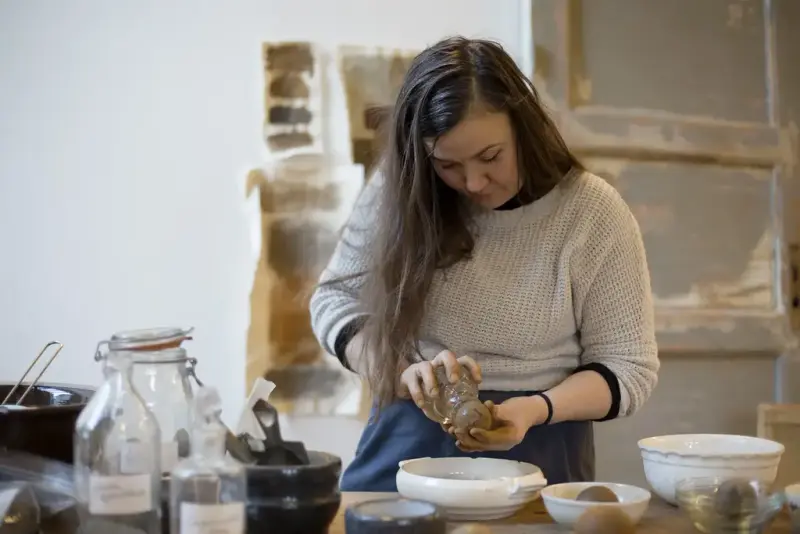
Photo: Inga Skålnes / BABEL Visningsrom for Kunst
Veslemøy Lilleengen (she/her, b.1975, Ørlandet) is a visual artist who works with textiles, sculptural installations, and performances. Lilleengen’s upbringing on her family’s farm in Vestråt, Ørlandet, as well as twenty years of living in the autonomous district of Svartlamoen in Trondheim, has influenced her art practice, governed by a do-it-yourself culture in which sustainability, collaboration, and activism are central values. Recent exhibitions include: Av Jord/From Dust at Telemark Kunstmuseum, Notodden, 2024; Stipendutstillingen/The grant exhibition at Kunstmuseet NordTrøndelag, Namsos, 2023; Årsutstillingen/The Annual exhibition, Norske kunsthåndverkere, Nasjonalmuseet, Oslo 2023; and Arvegods/Heirlooms at Nils Aas Kunstverksted, Inderøy, 2023. Lilleengen lives and works in Trondheim.
Production credits
Veslemøy Lilleengen
Grunntanker (Grounded Thoughts), 2021
installation and workshop series
The artist thanks the following individuals for the conversations, carrying help, testing, input, texts, criticism: Øystein Brynhildsvoll Hansen, Jon Alver Lilleengen, Aurelia Lilleengen, Lone Marie Tronsgård, Line Lilleengen, Bjørn Hulsund, Camilla Lilleengen, André Tribbensee, Inga Skålnes, Line Anda Dalmar, Margrethe Hopmo, Viktoria Belogrudovaite, Svartlamon neighborhood in Trondheim and my neighbors from gregus 11. A special thank you to my parents for instilling in me the importance of the table as a gathering point: Aud and Svein Lilleengen.
Commissioned by BABEL Visningsrom for Kunst.
Supported by Trondheim municipality

